Warhammer 40,000: Dawn of War 3 Review
Warhammer 40,000: Dawn of War 3
Updated: now with multiplayer impressions
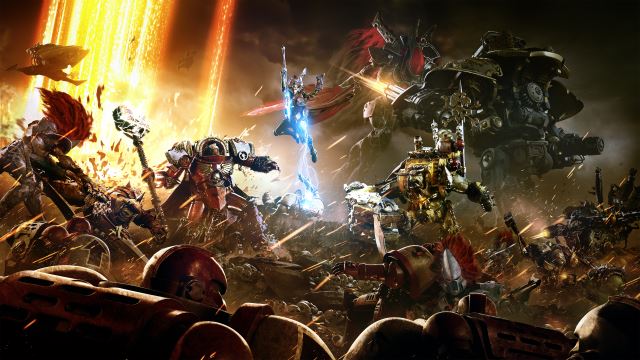
Verdict
Pros
- Strong campaign with three great factions
- Clever use of MOBA influences
- Barnstorming Elites
- Exciting multi-player mode
Cons
- AI seems reliant on line of sight
- Mission design can feel generic
Available on PC
Dawn of War 3 might not be the game to pull the RTS back to its late-1990s/early 2000s heyday, but it isn’t for want of trying. This is a smart, modern take on the genre, bringing in ideas from the the RTS’s bastard offspring, the MOBA, but retaining the high-level strategy and scale that once made Dawn of War and its ancestors so exciting.
It also works as a bridge between the two camps of Dawn of War fans, catering for those who loved the epic battles of the original title and fans of the more intimate, Diablo-influenced flavour of its sequel. There are signs of tension – of an RTS wanting to be all things to all men – but nothing that impedes a great RTS experience.
On the one hand, this is still your classic RTS. While the series has you capturing and holding resource points, rather than actively harvesting, the general pattern of building and developing your base, recruiting units, building your army and dominating the map will be familiar to anyone who ever battled their way through a Command & Conquer, a StarCraft, or even the more recent Halo Wars 2.
Where Dawn of War 3 differs is in demanding more attention to the nitty-gritty detail. This isn’t a game where superior numbers always win, or where you can afford to hurl cannon fodder troops at well-defended bases. The old ‘lasso a big group then click on your objective’ tactic doesn’t work.
Instead, it’s a game where understanding the active and passive capabilities of each unit is critical, so that you know how to use fast-moving assault troops, sneaky snipers and powerful mechs. Here, using the right powers at the right time can transform a rash push into a decisive mini-victory, while leaving massed troops to fend for themselves will leave them victim to a nasty counter.
Related: Best Strategy Games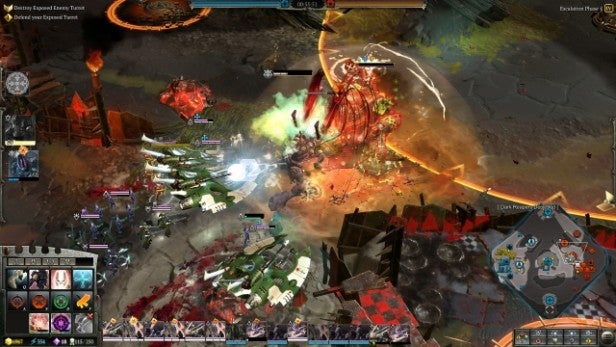
This is even more true of hero units, dubbed Elites. While there’s less emphasis on equipping and levelling them than there was in Dawn of War II, it’s still crucial that you get to grips with each one’s special attacks and support capabilities, switching quickly between heroes with the F keys to keep them moving, keep them slaying and – sometimes – to just keep them alive.
You’ll discover that the central Eldar hero, Farseer Macha, has a great one-two combo for breaking up groups of hostiles, hurling a spear that hits ‘em for six before detonating an energy pulse. You’ll learn to throw Blood Angel Master, Gabriel Angelos, into the fray, using his hammer to smash Ork units in close-combat, or scatter them in all directions. Even wannabe Ork boss Gorgutz has some interesting tactical abilities, with a whirling chain-claw attack that both damages the enemy and protects friendly troops with its radius.
These are just the first three of many Elites you’ll encounter, each with his or her own equivalents; some ability that can turn a skirmish in your favour, or help you to survive when all seems lost.
This is also a game where the landscape matters, not just because you need to take, hold and upgrade your resource points, but because it gives you opportunities for fortification – digging in to create a shielded position – and stealth. This is a must for surprise attacks on alarm-protected positions, or simply a great way to camp out and wipe out Ork patrols from relative safety.
Related: Best PC Games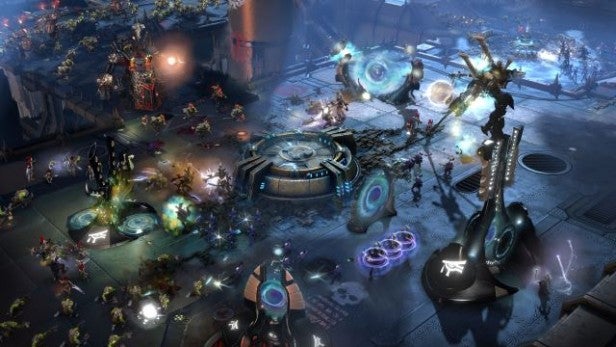
The single-player campaign structure is going to be somewhat controversial. Pitching Blood Angel space marines, Eldar and Orks into a three-way conflict over a sacred Eldar relic, it takes the rare step of revolving between the three factions rather than following the story from the viewpoint of just one. This means you’ll roughly alternate between, say, Gabriel Angelos clearing a flying fortress of Eldar, Farseer Macha assaulting Marine positions, and Gorgutz’s struggle for supremacy against rival Ork warbosses, then back to Angelos again.
This approach has a downside, in that it slows down character progression and can make the story a little confusing – although a bunch of optional side conversations do a great job of filling in any blanks. On the upside, it gives you more variation in the troops and heroes you’ll be wielding. Relic has done a great job of making all three leads likable in their own odd way, with Gabriel and Macha navigating politics and betrayal in the Imperial and Eldar hierarchies, while Gorgutz’s tale has its own brutish fun factor. After all, who can resist the Ork’s barbaric, rock n’roll approach to the business of waaarrgh?
More importantly, you get a chance to get your head around all three factions’ units, heroes and mechanics during the one campaign. This is important, because while there are clear similarities between specific units with specific roles across the three, each one also comes with its own unique abilities and perks.
The Orks, for example, can do a lot with battlefield scrap, whether dispensed from their own waaargh towers or simply left lying around. Individual units can scavenge the smaller piles and turn them into grenades and armour, while large chunks can be transformed by gretchen units into mechs, trucks and tanks. Get a load of trucks, pack ‘em with Orks and you have a fast-moving invasion force that hits the enemy hard before they even know what’s happening. Nice.
Related: Xbox Scorpio latest news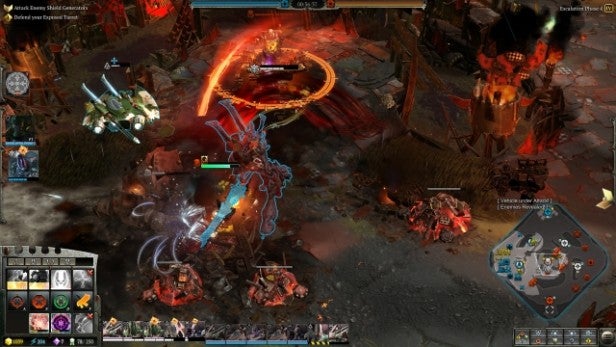
The Eldar, meanwhile, can seem a little weaker and slower on the move, but they have some fantastic stealth and melee units – plus some high-powered, revivable units you can field later on. Best of all, they have their webways: insta-teleport routes you can use to link the base with remote structures, enabling you to keep pouring units into battle as quickly as you can build them, provided you can get a gateway down. Once you’ve mastered the learning curve, these differences only become more interesting the more you play.
At its best, Dawn of War III’s campaign really works with each faction’s capabilities, not to mention the specific skills of individual units and heroes. You’ll need to juggle, switching from production at the base to groups of troops to your Elites, but the game makes this as easy as possible through the standard unit grouping tools, big, persistent Elite icons, a lot of audio feedback, and an effective mini-map.
At its worst, it feels a little generic, with a tendency to structure missions around a few front-loaded objectives, followed by a mid-match battle for resources and domination, culminating on a final, more challenging objective. Luckily, there are enough more interesting and inventive missions to offset this, and the switching between factions also helps alleviate the déjà vu.
Related: PS4 Pro vs PS4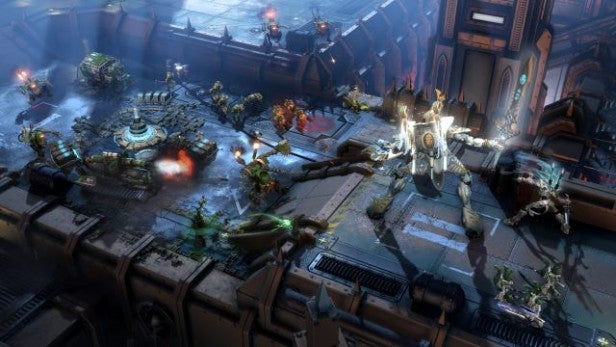
A bigger weakness is the AI. It isn’t bad, by any standards – and on higher difficulty levels, your enemies play a meaner and more probing game. However, your own troops can have that old RTS nasty habit of ignoring a skirmish going on nearby because they haven’t got line-of-sight, while their pathfinding can require a little bit of handholding if you don’t want, say, your space marine force splitting, with one half wandering within range of an Ork fortification.
Otherwise, Dawn of War III meets and occasionally exceeds the StarCraft II trilogy in redefining the RTS state of the art. It’s a fantastic-looking game, with superb, highly detailed animation, lovely scenery and, arguably, the best particle and explosion effects you’ll have seen in a PC strategy game. It has a little of that Diablo III cartoon quality, but when it imbues the design with so much character, that’s not a problem. Plus there’s certainly enough gruesome, gore-splattered, grimdark stuff going on to keep the Warhammer hardcore happy.
Relic understands the audience and what they want out of the franchise. Space Marines blasting away at hordes of Orks, with heavy bolters then sending jump-packed assault marines charging into battle; bloodthirsty greenskins smashing through Eldar ranks in their clap-trap mechs and dodgy motors. And while there’s no question that the UI is complex, it’s also logical, the campaign helping to ease out the learning curve so that you’re not bombarded with every function and secondary ability at once.
Related: Red Dead Redemption 2 latest news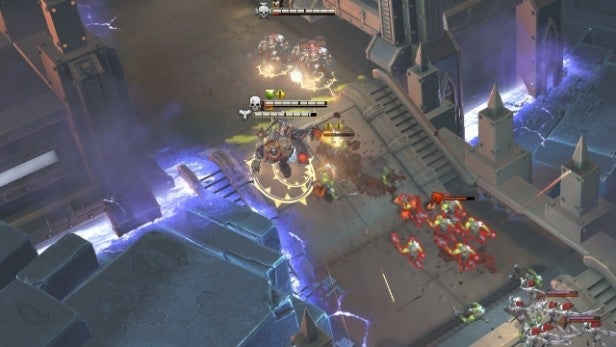
That’s a good thing, because there’s no shortage of depth in the multi-player game. At the moment, there’s just the one mode – Power Core – that takes Dawn of War’s classic gameplay and gives it a MOBA-like twist. While you’ll still need to build your base and grab and hold resource points, you’ll also need to tackle three sets of objectives, destroying shield generators that protect huge turrets that in turn protect the base’s power core.
This has a few effects on the way each match plays out. First, there are multiple chances to triumph or fail on the battlefield; it’s perfectly possible to storm the early game and take out the shield generators, but fall apart while tackling the turrets, giving the other side a good chance to fight back. Second, there’s no scope for simply building your base and turtling; if you’re not out there fighting for resource points and attacking the shield generators, you’ll just get swamped.
Most of all, you can sense the MOBA influence in the way that your Elites really matter. You can only field them when you’ve built up enough Elite points, and with some costing less than others, you need to think about whether it’s better to get your medium-sized guns out early or wait and get the big guns out at a decisive point.
You also need to know how to wield them and their capabilities, so that when you do get them out there they’re hitting the enemy hard. The pay-off lies in the fact that watching a big elite go to town on massed troops, or head-to-head with another monster, is undeniably spectacular – and when you come out of such a duel ahead, it’s another micro-victory.
Related: E3 2017 latest news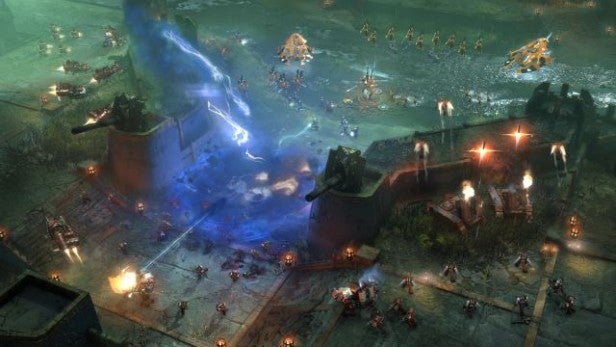
This is all fed by some brilliant army-building mechanics, where you can use the skulls earned in both single-player and multi-player activities to unlock new Elites and new Army Doctrines; faction-specific perks that enable you to strengthen specific units and capabilities and customise each faction to your own playing style.
When it all comes together, Dawn of War 3 multiplayer is hugely exciting and utterly absorbing; between building structures, recruiting units, grabbing resource points, holding resource points, defending your objectives and attacking the enemy’s, the game moves at a breathless pace. What’s more, the Elites work brilliantly in multiplayer. There’s nothing like slicing through Ork grunts in a massive Eldar Wraithknight, sending them flying with massive cannons or a spiralling distortion field.
It’s not, however, the most easy-going or accessible multi-player RTS. The sheer amount of stuff you need to take care of at any one time can be overwhelming, leaving you with little time, let alone resources, to defend resource points while attacking a turret while micro-managing the Elites heading your offensive force attempting to outflank enemy positions further down the map. At times, playing Dawn of War 3 can feel like playing an RTS and a MOBA at the same time, and that takes skill and practise.
And when it doesn’t all come together, Power Core mode can turn into an endless mid-game struggle, with both sides raising armies, hurling them at well-defended turrets and getting approximately nowhere for most of an hour. Not all players seem to understand how the mode works, which can leave, say, two players in a 3v3 match pushing forwards on the shield generators while the third throws troops against the enemy base to no discernible benefit.
I suspect we’re all on a learning curve here, and that Power Core will go from strength to strength, but I also suspect I’m not the only player hankering for some simpler, more straightforward action. It would, at least, be nice to have the option. For now, the best advice is to practice a lot against CPU opponents to get your basic build orders, tactics and Elite abilities down pat.
Buy Dawn of War 3 now from Amazon UK | Amazon.com
Verdict
There’s still something a little old-school about Dawn of War III’s RTS action, but when it scratches those same old itches so well, there’s very little reason to complain. It’s a game that takes new influences from the MOBA and uses them well, mixing up powerful Elites with tactically interesting units to create great battlefield moments, while spinning an interesting yarn from three different perspectives.
The lengthy single-player campaign gets you hooked and gives you a great grounding in some pretty complex gameplay. The multi-player is intense, challenging and a big departure from the average RTS, but also fast-paced, exciting and absorbing. Put the together and you have a Dawn of War with real energy and power.

